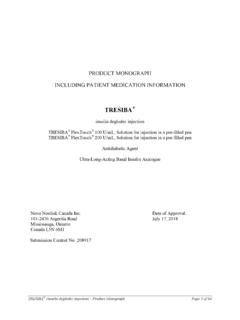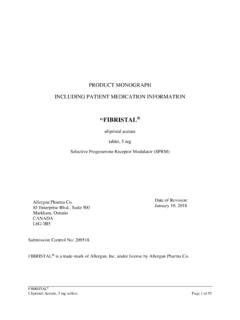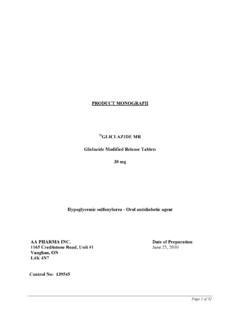Transcription of PRODUCT MONOGRAPH INCLUDING PATIENT …
1 RAVICTI PRODUCT MONOGRAPH Page 1 of 28 PRODUCT MONOGRAPH INCLUDING PATIENT medication information Pr RAVICTITM (glycerol phenylbutyrate) Oral Liquid g/mL Alimentary Tract and Metabolism PRODUCT (ATC Code: A16A X09) Horizon Pharma Ireland Ltd. Connaught House, 1st Floor 1 Burlington Road Dublin 4 Ireland Date of Preparation: March 16, 2016 Submission Control No: 174219 RAVICTI PRODUCT MONOGRAPH Page 2 of 28 Table of Contents PART I: HEALTH PROFESSIONAL information ..3 SUMMARY PRODUCT information ..3 INDICATIONS AND CLINICAL USE ..3 CONTRAINDICATIONS ..4 WARNINGS AND PRECAUTIONS ..4 ADVERSE REACTIONS ..5 DRUG INTERACTIONS ..8 DOSAGE AND ADMINISTRATION ..9 OVERDOSAGE ..11 ACTION AND CLINICAL PHARMACOLOGY ..11 STORAGE AND STABILITY.
2 14 DOSAGE FORMS, COMPOSITION AND PACKAGING ..14 PART II: SCIENTIFIC information ..15 PHARMACEUTICAL information ..15 CLINICAL TRIALS ..15 DETAILED PHARMACOLOGY ..21 TOXICOLOGY ..22 PART III: PATIENT medication information ..24 RAVICTI PRODUCT MONOGRAPH Page 3 of 28 Pr RAVICTITM (glycerol phenylbutyrate) Oral Liquid PART I: HEALTH PROFESSIONAL information SUMMARY PRODUCT information Route of Administration Dosage Form / Strength Clinically Relevant Nonmedicinal Ingredients Oral Oral Liquid, g/mL There are no nonmedicinal ingredients For a complete listing see Dosage Forms, Composition and Packaging section. INDICATIONS AND CLINICAL USE RAVICTI should be prescribed by a physician experienced in the management of urea cycle disorders (UCDs). RAVICTI (glycerol phenylbutyrate) is indicated for: Use as a nitrogen-binding agent for chronic management of adult and pediatric patients 2 years of age with UCDs who cannot be managed by dietary protein restriction and/or amino acid supplementation alone.
3 RAVICTI should be used with dietary protein restriction and, in some cases, dietary supplements ( , essential amino acids, arginine, citrulline, and protein-free calorie supplements). Limitations of Use: RAVICTI is not indicated for treatment of acute hyperammonemia in patients with UCDs. Safety and efficacy for treatment of patients with N-acetylglutamate synthase (NAGS) deficiency have not been established. Geriatrics (> 65 years of age) Clinical studies of RAVICTI did not include sufficient numbers of subjects 65 years of age to determine whether they respond differently than younger subjects (see WARNINGS AND PRECAUTIONS, Special Populations). Pediatrics patients < 2 Months of Age The use of RAVICTI in this age group is contraindicated (see WARNINGS AND PRECAUTIONS, Special Populations).
4 patients > 2 months and < 2 years of Age The safety and efficacy of RAVICTI in this age group have not been established. RAVICTI PRODUCT MONOGRAPH Page 4 of 28 CONTRAINDICATIONS RAVICTI is contraindicated in patients who are: hypersensitive to RAVICTI or its metabolites (phenylbutyric acid [PBA], phenylacetic acid [PAA], and phenylacetylglutamine [PAGN]) <2 months of age breastfeeding WARNINGS AND PRECAUTIONS General Acute hyperammonemic encephalopathy may occur in a number of patients even when they are on therapy. RAVICTI is not recommended for the management of acute hyperammonemia, which is a medical emergency. Cardiovascular RAVICTI is associated with an increase in heart rate (see ACTION AND CLINICAL PHARMACOLOGY, Cardiac Electrophysiology).
5 Caution should be observed in patients who have conditions that could be worsened by an increase in heart rate such as tachyarrhythmias or ischemic heart disease. Hepatic Since the metabolism and excretion of RAVICTI involves the liver, RAVICTI should be used with caution in patients with hepatic insufficiency (see ACTION AND CLINICAL PHARMACOLOGY, Hepatic Insufficiency). Neurologic The major metabolite of RAVICTI, PAA, is associated with signs and symptoms of neurotoxicity, INCLUDING somnolence, fatigue, lightheadedness, headache, dysgeusia, hypoacusis, disorientation, impaired memory, and exacerbation of preexisting neuropathy were observed at plasma PAA concentrations 500 g/mL in a study of cancer patients who were administered intravenous (IV) PAA. In this study, adverse events were reversible.
6 In controlled clinical trials in UCD patients who had been on sodium phenylbutyrate prior to administration of RAVICTI, mean (standard deviation or SD) maximum PAA concentrations after dosing with RAVICTI were ( ) g/mL in adult patients and ( ) g/mL in pediatric patients (N=26). No correlation between PAA levels and neurotoxicity symptoms was identified in UCD patients . If symptoms of vomiting, nausea, headache, somnolence, confusion, or sleepiness are present in the absence of high ammonia or other intercurrent illnesses, measure plasma PAA and plasma PAA to PAGN and consider reduction of RAVICTI dosage if the PAA level exceeds 500 g/mL or the PAA:PAGN ratio exceeds RAVICTI PRODUCT MONOGRAPH Page 5 of 28 Pancreatic Insufficiency Pancreatic lipases may be necessary for intestinal hydrolysis of RAVICTI, allowing release of PBA and subsequent formation of PAA, the active moiety.
7 It is not known whether pancreatic and extrapancreatic lipases are sufficient for hydrolysis of RAVICTI. If there is inadequate intestinal hydrolysis of RAVICTI, impaired absorption of PBA and hyperammonemia could occur. Renal RAVICTI has not been studied in patients with impaired renal function. As RAVICTI excretion involves the kidneys, it should be used with caution in patients with renal insufficiency, INCLUDING those with end-stage renal disease (ESRD) or those on hemodialysis. Special Populations Pregnant Women: There are no adequate and well controlled studies of RAVICTI in pregnant women. Studies in rats have shown reproductive toxicity (see TOXICOLOGY, Reproductive Toxicology). RAVICTI should be used during pregnancy only if the potential benefit justifies the potential risk to the fetus.
8 Nursing Women: It is unknown if RAVICTI is excreted in human milk. It has not been determined if RAVICTI or its metabolites are secreted in human milk and therefore the use of RAVICTI is contraindicated during breastfeeding (see CONTRAINDICATIONS). Pediatrics patients <2 Months of Age: The use of RAVICTI in this age group is contraindicated. Children under 2 months of age may have immature pancreatic exocrine function that could impair RAVICTI hydrolysis and release of PBA as well as subsequent formation of PAA, the active moiety. If pancreatic and extrapancreatic lipases are insufficient for hydrolysis of RAVICTI in this age group, impaired absorption of PBA and hyperammonemia could occur. patients <2 Years of Age: The safety and efficacy of RAVICTI in this age group have not been established.
9 Geriatrics (> 65 years of age): Clinical studies of RAVICTI did not include sufficient numbers of subjects 65 years of age to determine whether they respond differently than younger subjects. In general, dose selection for a newly diagnosed elderly PATIENT should be cautious, usually starting at the low end of the dosing range, reflecting the greater frequency of concomitant disease, INCLUDING decreased hepatic or renal function, or concomitant drug therapy. Monitoring and Laboratory Tests: Adjustment may be based on monitoring of plasma ammonia, glutamine, urinary phenylacetylglutamine (UPAGN) and/or plasma PAA and PAGN as well as the ratio of plasma PAA to PAGN (see Recommended Dose and Dosage Adjustment). ADVERSE REACTIONS Adverse Drug Reaction Overview The incidence of serious adverse events in long term clinical trials with RAVICTI was 26% and consisted primarily of hyperammonemia (18%).
10 RAVICTI PRODUCT MONOGRAPH Page 6 of 28 The most common adverse drug reactions among all patients taking RAVICTI in clinical trials include diarrhea, flatulence headache, decreased appetite, vomiting, nausea, fatigue and skin odor. Adverse drug reactions that resulted in clinical intervention in UCD patients who participated in clinical trials were mostly gastrointestinal reactions (flatulence, nausea, vomiting, abdominal distention) or neurological reactions (dysgeusia, lethargy, speech disorder, paresthesia, tremor). Clinical Trial Adverse Drug Reactions Because clinical trials are conducted under very specific conditions, the adverse reaction rates observed in the clinical trials may not reflect the rates observed in practice and should not be compared to the rates in the clinical trials of another drug.




![[Product Monograph Template - Standard]](/cache/preview/1/3/7/9/6/d/a/a/thumb-13796daa617bc65beb773a3c01593750.jpg)



![[Product Monograph Template - Standard] - …](/cache/preview/a/9/a/b/c/6/8/3/thumb-a9abc683523644e52c439669ba6e5b27.jpg)


